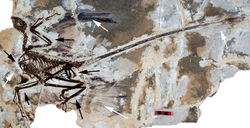Microraptoria
| Microraptoria Temporal range: 125–76.5 Ma | |
|---|---|
 | |
| Fossil specimen of a Microraptor, with white arrows pointing at preserved feathers | |
| Scientific classification | |
| Kingdom: | Animalia |
| Phylum: | Chordata |
| Class: | Reptilia |
| Clade: | Dinosauria |
| Order: | Saurischia |
| Suborder: | Theropoda |
| Family: | †Dromaeosauridae |
| Clade: | †Microraptoria Senter et al., 2004 |
| Genera | |
| Synonyms | |
| |
Microraptoria (Greek, μίκρος, mīkros: "small"; Latin, raptor: "one who seizes") is a clade of paravian theropods known for long feathers on their legs They appeared 125 million years ago in China. Many may have been semi-arboreal gliders. Microraptorians were relatively small; adult specimens of Microraptor range between 77–90 centimetres long (2.53–2.95 ft) and weigh up to 1 kilogram (2.2 lb), making them some of the smallest known dinosaurs.[1][2] The largest, Hesperonychus, Graciliraptor and Sinornithosaurus, were no more than 1.8 metres long.[1]
Classification
Microraptoria is usually classified as clade of dromaeosaurid. Senter and colleagues expressly coined the name without the subfamily suffix -inae to avoid perceived issues with erecting a traditional family-group taxon, should the group be found to lie outside dromaeosauridae proper.[3] Sereno offered a revised definition of the sub-group containing Microraptor to ensure that it would fall within Dromaeosauridae, and erected the subfamily Microraptorinae, attributing it to Senter et al., though this usage has only appeared on his online TaxonSearch database and has not been formally published.[4]
The cladogram below follows a 2012 analysis by paleontologists Phil Senter, James I. Kirkland, Donald D. DeBlieux, Scott Madsen and Natalie Toth.[5]
| Dromaeosauridae |
| |||||||||||||||||||||||||||||||||||||||||||||||||||||||||||||||||||||||||||
| |
See also
Footnotes
- 1 2 Holtz, Thomas R. Jr. (2011) Dinosaurs: The Most Complete, Up-to-Date Encyclopedia for Dinosaur Lovers of All Ages, Winter 2010 Appendix.
- ↑ Chatterjee, S., and Templin, R.J. (2007). "Biplane wing planform and flight performance of the feathered dinosaur Microraptor gui." Proceedings of the National Academy of Sciences, 104(5): 1576-1580.
- ↑ Senter, Phil; Barsbold, R.; Britt, Brooks B.; Burnham, David B. (2004). "Systematics and evolution of Dromaeosauridae (Dinosauria, Theropoda)". Bulletin of the Gunma Museum of Natural History. 8: 1–20.
- ↑ Sereno, P. C. 2005. Stem Archosauria—TaxonSearch [version 1.0, November 7, 2005
- ↑ Senter, P.; Kirkland, J. I.; Deblieux, D. D.; Madsen, S.; Toth, N. (2012). Dodson, Peter, ed. "New Dromaeosaurids (Dinosauria: Theropoda) from the Lower Cretaceous of Utah, and the Evolution of the Dromaeosaurid Tail". PLoS ONE. 7 (5): e36790. doi:10.1371/journal.pone.0036790. PMC 3352940
 . PMID 22615813.
. PMID 22615813.
References
3."Expand and Life history of a basal bird:morphometrics of the Early Cretaceous Confuciusornis" Luis M Chiappe, Jesús Marugán-Lobón,Shu'an Ji & Zhonghe Zhou(2008)
External links
- 1.http://www.paleodb.org/cgi-bin/bridge.pl?a=basicTaxonInfo&taxon_no=143267
- 2.http://www.taxonsearch.org/dev/taxon_edit.php?tax_id=483&Action=View
- 3.http://theropoddatabase.blogspot.com/2010/03/article-1311-means-lewisuchinaeidae-is.html
| Wikispecies has information related to: Microraptoria |

